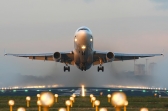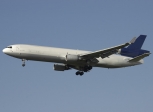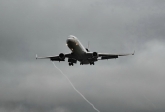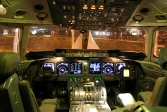
The McDonnell Douglas MD-11 is a three-engine medium- to long-range widebody jet airliner, manufactured by McDonnell Douglas and, later, by Boeing Commercial Airplanes. Based on the DC-10, it features a stretched fuselage, increased wingspan with winglets, refined airfoils on the wing and smaller tailplane, new engines and increased use of composite materials. Two of its engines are mounted on underwing pylons and a third engine at the base of the vertical stabilizer. It also features an all-digital glass cockpit that decreases the flight deck crew from the three required on the DC-10 to two by eliminating the necessity for a flight engineer.
The MD-11 is a medium to long-range widebody airliner, with two engines mounted on underwing pylons and a third engine at the base of the vertical stabilizer. It is based on the DC-10, but featuring a stretched fuselage, increased wingspan with winglets, refined aerofoils on the wing and tailplane, new engines and increased use of composites. The winglets are credited with improving fuel efficiency by about 2.5%. The MD-11 has a smaller empennage than the DC-10 it is based upon.
The MD-11 features a two-crew cockpit that incorporates six interchangeable CRT-units and advanced Honeywell VIA 2000 computers. The cockpit design is called Advanced Common Flightdeck (ACF) and is shared with the Boeing 717. Flight deck features include an Electronic Instrument System, a dual Flight Management System, a Central Fault Display System, and Global Positioning System. Category IIIb automatic landing capability for bad-weather operations and Future Air Navigation Systems are available.
The MD-11 incorporates hydraulic fuses not included in the initial DC-10 design, to prevent catastrophic loss of control in event of a hydraulic failure.
Plane info
Cruise speed: 945 km/h
Total range: 12 655 km
Engines: 3 x Pratt & Whitney PW4460
Aircraft dimensions
Wingspan: 51.66 m
Length: 58.65 m
Height: 17.60 m
Cabin
Passengers: up to 410



















